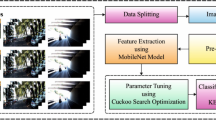Abstract
According to statistics, the incidence of traffic accidents in China is far greater than that of developed countries such as the USA and Germany. Nearly 100,000 people die in traffic accidents every year in China. The use of the assisted driving system effectively reduces the incidence of traffic accidents, while road surface object recognition is the key research object in the assisted driving system. At present, in the research on the recognition of pavement objects, there are problems such as low recognition rate and long recognition time, which cannot play the role of assisting driving. In response to these problems, this paper proposes a research on pavement object recognition based on machine learning, including analysis of key technologies of machine learning and optimization of related algorithms. In order to verify the feasibility of the proposed method in the assisted driving system, the research results are applied to the road surface object recognition device and the experiment is carried out under the actual traffic environment. The results show that in the selected experimental scenes, the recognition accuracy of the road surface object recognition device applying the research results of this paper is 100%, and the recognition time is far lower than the traditional road object recognition method. The results show that the proposed method can quickly and effectively identify the pavement object, and then assist the driver to control the vehicle, which has good applicability in the assisted driving system.







Similar content being viewed by others
References
Lichun Y (2017) Research on hidden dangers and countermeasures of road traffic safety in China. Times Agric Mach 11:73
Anonymous (2018) Analysis of the relationship between human factors and traffic accidents of automobile drivers. Times Auto 303(12):19–20
Jianquan Ma, Zhi L (2017) Internet car development and key technology analysis. Automob Parts 8:40–41
Viola P, Jones M, Snow D (2003) Detecting pedestrians using patterns of motion and appearance. In: The 9th IEEE international conference on computer vision. pp 734–741
Viola P, Jones MJ, Snow D (2005) Detecting pedestrians using patterns of motion and appearance. Int J Comput Vision 63(2):153–161
Huval B, Wang T, Tandon S, et al (2015) An empirical evaluation of deep learning on highway driving. arXiv preprint arXiv: 1504.01716
Costea AD, Nedevschi S (2016) Semantic channels for fast pedestrian detection. In: IEEE conference on computer vision and pattern recognition (CVPR). IEEE, pp 2360–2368
Zhou Y, Xu R, Hu X et al (2006) A robust lane detection and tracking method based on computer vision. Meas Sci Technol 17(4):736–745
Tiantian H et al (2016) Pedestrian detection based on improved HOG-LBP features. J Inf Eng Univ 17(03):298–302
Chen Y, Ye F, Xiao F et al (2016) Traffic sign detection and recognition based on HSV space and shape features. J Jianghan Univ (Nat Sci) 44(2):119–125
Xu Yuan X, Xiaoliang LC et al (2016) Pedestrian detection based on SVM classifier and HOG feature extraction. Comput Eng 42(1):56–60
Pengfei L, Ming A (2019) Small target vehicle detection algorithm based on feature fusion. J Henan Univ Sci Technol Nat Sci Ed 40(2):40–44
Xue C (2017) Machine learning——the booster of artificial intelligence revolution. Electron Technol Softw Eng 13:255
Chunxia C (2017) Analysis on the development and application of machine learning. Inf Syst Eng 8:99–100
Chen J, Zhou S, Yan H (2017) A method for selecting the word frequency-sifting hybrid feature for spam recognition. J South China Univ Technol (Nat Sci Ed) 45(3):82–88
Yakun L (2018) Comparative study of risk prediction models of securities companies based on machine learning. Fortune Today 1:198
Zhonglin Z, Yajie W, Juan C et al (2017) Application and challenge of health big data in health care. Hainan Med J 28(2):173–176
Ming Y (2018) Research on APP advertising conversion rate prediction based on machine learning hybrid algorithm. Data Anal Knowl Discov 2(11):2–9
Minghui Q, Zhixuan X (2019) Research on dynamic identification and effect verification of consumer brand decision preference based on machine learning. Nankai Manag Rev 22(03):66–76
Kaustubh G (2018) How to use artificial intelligence to make synergy of sensor data? Sensor World 24(272):32–34
Cao Y, Cui Z, Wu G et al (2018) Research on data noise identification and cleaning technology of air conditioning system based on machine learning algorithm. Build Energy Conserv 46(327):85–89
Anonymous (2018) Some basic mathematical principles in the machine learning modeling process. Sci Technol Econ Guide 26(24):120–122
Gharakhanian A, Hanyang Z (2017) Unsupervised learning, GAN and reinforcement learning will build the future of machine learning. Robot Ind 2:22–25
Yangyang Z, Jiping L, Shenghua X et al (2017) A geographically weighted regression method based on semi-supervised learning. Acta Geoda Sinica 46(1):123–129
Liu Q, Zhai J, Zhang Z et al (2018) Review of deep reinforcement learning. Chin J Comput 1:1–27
Yang Z, Wei Yu, Liang P, Guo H, Xia L, Zhang F, Ma Y, Ma J (2019) Deep transfer learning for military object recognition under small training set condition. Neur Comput Appl 31(10):6469–6478
Acknowledgements
This work was supported by Shandong Important R&D Program of China (No. 2018YFJH0306).
Author information
Authors and Affiliations
Corresponding author
Ethics declarations
Conflict of interest
The authors declared that they have no conflicts of interest to this work.
Additional information
Publisher's Note
Springer Nature remains neutral with regard to jurisdictional claims in published maps and institutional affiliations.
Rights and permissions
About this article
Cite this article
Gao, H., Yuan, L. Research on key technology of pavement object recognition based on machine learning. Neural Comput & Applic 32, 5483–5493 (2020). https://doi.org/10.1007/s00521-019-04643-6
Received:
Accepted:
Published:
Issue Date:
DOI: https://doi.org/10.1007/s00521-019-04643-6




